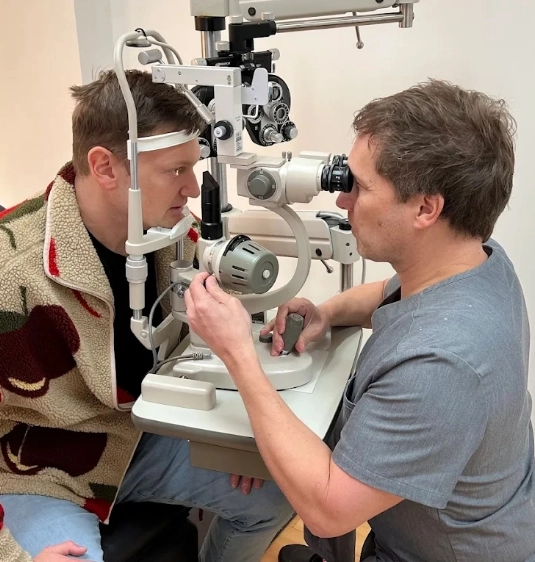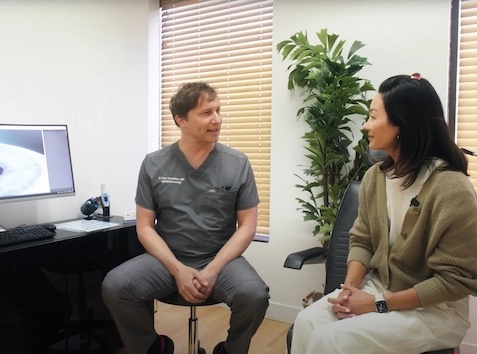
SMILE LASIK
If you’re looking for a minimally invasive alternative to LASIK, SMILE may be the vision correction procedure that fits your eyes—and your lifestyle. SMILE (Small Incision Lenticule Extraction) is a flap-free, bladeless laser eye surgery designed to correct nearsightedness and astigmatism with precision, comfort, and rapid recovery.
As the first surgeon to perform SMILE on the West Coast, Dr. Rex Hamilton offers this advanced procedure in Beverly Hills, serving patients from across Los Angeles. With decades of experience in refractive surgery, he delivers personalized care and trusted results—helping people see more clearly through modern, minimally invasive vision correction.

SMILE at a Glance
SMILE (Small Incision Lenticule Extraction) is a minimally invasive laser eye surgery that corrects myopia and astigmatism without creating a corneal flap. Using a femtosecond laser, SMILE reshapes the cornea through a tiny incision—offering fast recovery, reduced dryness, and long-term vision correction with fewer post-operative side effects.

What is SMILE Eye Surgery?
SMILE eye surgery—short for Small Incision Lenticule Extraction—is a minimally invasive laser vision correction procedure used to treat nearsightedness (myopia) and astigmatism. Like LASIK and PRK, SMILE is a form of refractive surgery designed to reshape the cornea for better focus and sharper vision. But unlike traditional LASIK eye surgery, SMILE does not require the creation of a corneal flap.
Instead, SMILE uses a femtosecond laser to create a small, lens-shaped piece of tissue called a lenticule within the deeper layers of the cornea. This lenticule is then carefully removed through a tiny incision—just a few millimeters wide—subtly altering the shape of the cornea to correct refractive errors. The entire procedure is flap-free, all-laser, and performed in a
Trusted Source
What Is Small Incision Lenticule Extraction?
American Academy of Ophthalmology
Go to Source
single step.
SMILE is FDA-approved and widely regarded as one of the most advanced forms of laser eye surgery available today. By preserving more of the corneal structure, it offers a gentler alternative to LASIK that may reduce the risk of dryness and certain side effects. With over
Trusted Source
SMILE
American Refractive Surgery Council
Go to Source
10 million procedures
performed globally, SMILE has become one of the most in-demand vision correction procedures—reflecting its growing reputation for safety, innovation, and excellent outcomes.
Timofey Mozgov SMILE Experience
What’s the Difference Between SMILE and LASIK Eye Surgery?

SMILE and LASIK are both advanced forms of laser vision correction designed to treat refractive errors like myopia and astigmatism. However, the techniques used—and the experience for the patient—are quite different.
During a traditional LASIK procedure, a femtosecond laser is used to create a hinged flap in the outer cornea. An excimer laser then reshapes the tissue underneath the flap to correct the eye’s focusing ability. While LASIK has helped millions of patients achieve clear vision, the creation of a corneal flap does introduce a small risk of flap-related complications—especially in the event of future eye trauma.
SMILE, or Small Incision Lenticule Extraction, takes a flap-free approach. Instead of creating a corneal flap, a femtosecond laser is used to create a small lenticule inside the cornea. That lenticule is then removed through a micro-incision, subtly reshaping the cornea from within. This minimally invasive technique preserves more of the corneal surface and may result in fewer side effects, such as dryness or sensitivity during healing. In addition, patients undergoing SMILE have no lifestyle restrictions the day after the procedure.
Both procedures deliver excellent visual outcomes. The best option depends on factors like corneal thickness, visual prescription, lifestyle, and long-term goals. As a board-certified ophthalmologist and refractive surgeon, Dr. Hamilton carefully evaluates each patient to determine whether LASIK, SMILE, PRK, or EVO ICL offers the best path forward.
What are the Benefits of SMILE LASIK?
SMILE LASIK offers a modern, minimally invasive approach to laser vision correction with a range of benefits that make it an appealing alternative to traditional LASIK and PRK. Backed by advanced technology and millions of successful outcomes worldwide, SMILE is reshaping what’s possible in refractive surgery.

- Minimally Invasive, Flap-Free Procedure
Because the SMILE procedure is performed through a small incision without creating a corneal flap, it preserves more of the eye’s natural structure. This all-laser technique reduces the chance of complications and supports a more stable corneal surface after surgery. The SMILE procedure is super easy to go through as a patient. There is no pressure on the eye, and with only one laser required, Dr. Hamilton typically completes the procedure on both eyes in only 8 minutes! - Comfortable Recovery
By avoiding disruption to the corneal flap and nerves, SMILE may lead to a lower incidence of post-operative dryness. Many patients experience little to no discomfort during the healing process, and eye drops are typically used for a shorter duration compared to other laser eye surgeries. - Fewer Side Effects
The smaller incision used in SMILE helps reduce the risk of flap-related complications and irritation. This can be especially beneficial for patients with active lifestyles or those who may be more prone to dry eye symptoms. - High Patient Satisfaction
Patients who have SMILE LASIK report even higher post-operative satisfaction than those who undergo traditional LASIK—underscoring its effectiveness, comfort, and visualTrusted Source Comparing Patient-Reported Outcomes of Laser In Situ Keratomileusis and Small-Incision Lenticule Extraction: A Review Chiam NPY, Mehta JS Go to Source outcomes.
- No Lifestyle Restrictions
Patients undergoing SMILE can return to all activities the day after surgery. This includes using eye makeup, showering, swimming, workouts, sports….Dr. Hamilton tells his patients “you can get in the UFC ring the day after surgery…but I don’t recommend it!” This underscores the fact that there is no flap and, thus, no “moving parts” that need to heal with the SMILE procedure. - Fast Visual Recovery
The recovery time after SMILE is often swift—many patients notice clearer vision by the next day and feel ready to return to work, school, or normal routines within 24 hours. Vision continues to sharpen and stabilize in the days that follow. - Proven Success
SMILE is FDA-approved and supported by strong clinical data. With more than 10 million procedures performed worldwide, it has a well-established record of safety, precision, and long-term satisfaction. - Reduced Dependence on Glasses and Contacts
One of the most rewarding aspects of SMILE is the potential to significantly reduce or eliminate the need for corrective lenses. Patients often enjoy greater visual freedom and ease in daily life after surgery.

SMILE Technology: The Power of the ZEISS VisuMax Laser
The ZEISS VisuMax® femtosecond laser is at the heart of SMILE eye surgery, delivering unmatched precision, speed, and comfort. This state-of-the-art technology uses ultra-fast laser pulses to create a smooth, curved lenticule within the cornea—all without the need for a blade or corneal flap.
Unlike other laser systems, the VisuMax is specifically engineered for small-incision procedures like SMILE, offering a minimally invasive approach that supports faster recovery and preserves more of the eye’s natural integrity. It also plays a critical role in all-laser LASIK procedures, making it one of the most versatile and advanced tools in modern refractive surgery.
The VisuMax patient interface is the most comfortable available…patients notice only a small amount of pressure, similar to placing a contact lens in the eye, during the procedure. Other femtosecond laser systems require a much higher level of pressure on the eye which some patients find uncomfortable.
With over 10 years of experience with the VisuMax laser, Dr. Hamilton is able to perform laser vision correction with a level of control and gentleness that enhances both safety and patient comfort—helping to redefine what’s possible in vision care.

Am I a Good Candidate for SMILE?
SMILE may be an excellent option for patients who are not ideal candidates for traditional LASIK. Because this minimally invasive procedure avoids the creation of a corneal flap, it can be a safer, more comfortable alternative for those with specific anatomical or lifestyle considerations.
You may be a candidate for SMILE LASIK if you:

- Are 22 years of age or older
- Have mild to moderate myopia (nearsightedness) with or without astigmatism
- Have a stable glasses or contact lens prescription
- Have healthy eyes, free from infections or conditions that affect healing
- Are looking for a flapless alternative to laser vision correction
SMILE is not recommended for individuals who are pregnant or breastfeeding, or those diagnosed with eye diseases such as glaucoma, keratoconus, or uncontrolled dry eye. A detailed eye exam is essential to assess your corneal thickness, refractive stability, and overall ocular health before moving forward with any vision correction procedure.
If SMILE isn’t the best fit for your eyes, Dr. Hamilton may recommend an alternative laser eye surgery technique, such as LASIK or PRK, or a non-laser procedure such as EVO ICL, tailored to your unique needs.
Wondering if SMILE is right for you? Schedule your personal consultation with Dr. Hamilton to explore your options.
How Should I Prepare for My SMILE Procedure?
Preparing for SMILE vision correction surgery begins with a comprehensive consultation. During this visit, Dr. Rex Hamilton will personally perform a detailed eye exam, assess your corneal health, and review your vision goals. This evaluation helps determine whether SMILE—or another procedure like LASIK, PRK or EVO ICL—is the best option for your unique needs. It’s also a time to ask questions, understand the surgical process, and take the next step toward better vision.
Before Your Consultation
To ensure accurate testing and precise planning, you’ll need to temporarily stop wearing contact lenses:
- Soft contact lenses should be discontinued at least 3 to 5 days before your appointment
- Hard or gas-permeable lenses should be stopped at least 2 weeks in advance
Bringing your current glasses and/or a photo of your contact lens prescription or packaging can also be helpful for establishing your baseline vision correction.
Pre-Surgery Instructions
Once you’re scheduled for the SMILE procedure, Dr. Hamilton’s team will provide specific pre-operative guidelines, which may include:
- Medication review: Share a complete list of any medications, supplements, or eye drops you use. Some may need to be paused prior to surgery.
- Avoiding irritants: Refrain from wearing eye makeup, lotions, or facial creams on the day of your surgery, as these products can interfere with the laser or cause irritation.
- Personal care on the day of surgery: Arrive with a clean face, no fragrance or jewelry, and follow any dietary instructions provided.
- Transportation plan: Arrange for a trusted adult to drive you home, as your vision may be blurry immediately after the procedure and, because a mild sedative is used prior to the procedure, you may be too drowsy to drive safely.
Dr. Hamilton and his team are committed to making the experience as smooth and stress-free as possible—with personalized support before, during, and after your laser vision correction procedure.

What to Expect During SMILE LASIK
SMILE is a quick, outpatient laser vision correction procedure performed entirely by Dr. Rex Hamilton using advanced femtosecond laser technology. The entire process is typically completed in under 4 minutes per eye, with most patients spending about an hour at the office to allow time for preparation and post-operative care.
Before the Procedure
When you arrive, Dr. Hamilton’s team will review your aftercare instructions and help you get settled. Anesthetic eye drops will be administered to fully numb your eyes, and you may be offered a mild sedative to help you relax. A gentle device will be used to keep your eyelids open during the procedure, ensuring comfort and safety throughout.
The SMILE Procedure
Using the ZEISS VisuMax® femtosecond laser, Dr. Hamilton will create a thin, lens-shaped layer of tissue—called a lenticule—within the middle layer of your cornea. This lenticule is then carefully removed through a micro-incision just a few millimeters wide. As the lenticule is removed, the shape of the cornea changes, correcting the way your eye focuses light.
There are no blades, no excimer laser, and no corneal flap involved. This all-laser, minimally invasive approach helps preserve more of your natural corneal structure while supporting a smooth recovery.
Immediately After Surgery
Once your procedure is complete, Dr. Hamilton will examine your eyes and guide you to a quiet area to rest briefly. Because your vision may be hazy for a few hours, a trusted adult should drive you home. Most patients begin noticing visual improvement as early as the next day.
With precision, comfort, and efficiency, SMILE represents a new generation of refractive surgery—performed with care and expertise from start to finish.


“Every SMILE procedure I perform is tailored to the unique structure of each patient’s eye—for vision correction that’s as personal as it is precise.”– Dr. Rex Hamilton
How Long Does Recovery Take After SMILE?
Recovery after SMILE is typically fast, low-maintenance, and comfortable. Most patients will feel comfortable performing all of their activities of daily living, including driving, the day after the surgery.
Immediately After Your Procedure
You’ll need a trusted adult to drive you home, as your vision may be slightly hazy following surgery. Plan to rest for the remainder of the day and avoid screen time, reading, or any activity that puts strain on the eyes. Mild symptoms—such as light sensitivity, watering, or a gritty sensation—are common and usually resolve within a few hours.
Post-Operative Eye Care Tips
- Use all prescribed eye drops exactly as directed to support healing and reduce inflammation
- Artificial tears can help relieve any dryness or temporary fluctuations in vision
Follow-Up and Long-Term Recovery
Dr. Hamilton will see you for a follow-up visit within a few days after surgery to assess your initial healing. Additional check-ins will be scheduled in the weeks that follow to monitor your progress and ensure long-term success.
While most patients reach functional vision quickly, it may take a few days for a slight fog to disappear and for your sight to fully stabilize. Compared to traditional LASIK, SMILE patients often report less post-operative dryness and irritation due to the flapless design of the procedure.
With proper care and guidance, SMILE recovery is smooth—and the path to clear, independent vision begins right away.

Why Choose Dr. Rex Hamilton?
When it comes to SMILE vision correction, few eye surgeons offer the depth of experience, leadership, and personal care that Dr. Rex Hamilton brings to each procedure. A board-certified ophthalmologist and nationally recognized expert in refractive surgery, Dr. Hamilton was the first surgeon to perform SMILE on the West Coast in 2017—shortly after its FDA approval. His early adoption of this advanced, minimally invasive technique helped introduce the SMILE procedure to patients across the greater Los Angeles area.
“Being the first surgeon to perform SMILE on the West Coast wasn’t just a milestone—it was a commitment to staying at the forefront of ophthalmology for my patients.” – Dr. Rex Hamilton
As the former Director of the UCLA Laser Refractive Center, Dr. Hamilton has spent decades at the forefront of ophthalmology, training the next generation of refractive surgeons and contributing to groundbreaking research in laser eye surgery. His academic work has included studies on femtosecond laser technology, corneal surgery, and optimizing outcomes in LASIK and cataract procedures.
Dr. Hamilton and his team published peer-reviewed articles
Dr. Hamilton personally analyzes all pre-operative testing, including detailed corneal imaging and refractive measurements. He remains involved at every step of the process—from consultation to surgery and follow-up—ensuring that each patient receives a tailored treatment plan and expert care. You’ll never be handed off to another provider.
With extensive experience in SMILE, LASIK, PRK, EVO ICL, and refractive lens exchange, Dr. Hamilton offers a full range of vision correction procedures. His honest, individualized approach helps patients choose the safest and most effective option for their eyes, lifestyle, and long-term goals.

Frequently asked questions
No—SMILE is a virtually painless procedure. Before surgery, numbing eye drops are applied to keep you comfortable throughout the process. Most patients report feeling only slight pressure during treatment, with minimal discomfort afterward.
Many patients notice an improvement in vision within a few hours of surgery. While results vary, most experience stable, clear vision within the first few days. Full visual recovery and sharpness typically continue to improve over the first week. Vision is good enough the day after the procedure to drive and perform most activities.
SMILE is widely regarded as a safe and effective vision correction surgery, but like any procedure, it carries some risk. Possible side effects may include temporary dryness, glare or halos at night, mild inflammation, or slight under- or
Trusted Source
What Is Small Incision Lenticule Extraction?
American Academy of Ophthalmology
Go to Source
over-correction.
These are typically short-lived and can be managed with eye drops or additional treatment if needed.
Yes, SMILE permanently reshapes the cornea to correct refractive errors like nearsightedness and astigmatism. However, it does not prevent age-related vision changes such as presbyopia, which can affect near vision over time. Age-related vision changes such as presbyopia can still be effectively treated in patients who had SMILE previously.
SMILE is considered an elective procedure and is not usually covered by insurance plans. However, patients often use HSA or FSA funds to help with the cost. Financing options are also available to make treatment more affordable.
The cost of SMILE in Beverly Hills is comparable to other advanced laser vision correction procedures. Dr. Hamilton’s team will provide a personalized quote during your consultation, along with information on payment plans and flexible financing options.
1 American Academy of Ophthalmology. What Is Small Incision Lenticule Extraction? Available: https://www.aao.org/eye-health/treatments/what-is-small-incision-lenticule-extraction Accessed June 26, 2025.
2 American Refractive Surgery Council. SMILE. Available: https://americanrefractivesurgerycouncil.org/smile-eye-surgery/. Accessed June 27, 2025.
3 Chiam NPY, Mehta JS. Comparing Patient-Reported Outcomes of Laser In Situ Keratomileusis and Small-Incision Lenticule Extraction: A Review. Asia Pac J Ophthalmol (Phila). 2019 Sep-Oct;8(5):377-384. doi: 10.1097/APO.0000000000000258. PMID: 31478935; PMCID: PMC6784778. Available: https://pubmed.ncbi.nlm.nih.gov/31478935/. Accessed June 26, 2025.
4 American Academy of Ophthalmology. What Is Small Incision Lenticule Extraction? Available: https://www.aao.org/eye-health/treatments/what-is-small-incision-lenticule-extraction Accessed June 26, 2025.